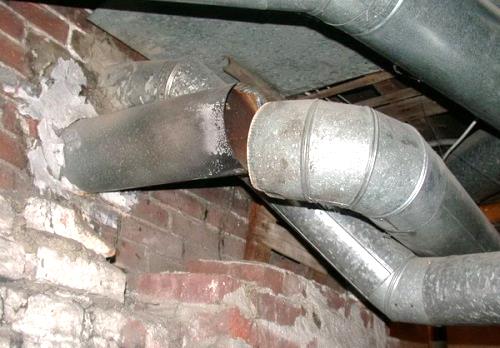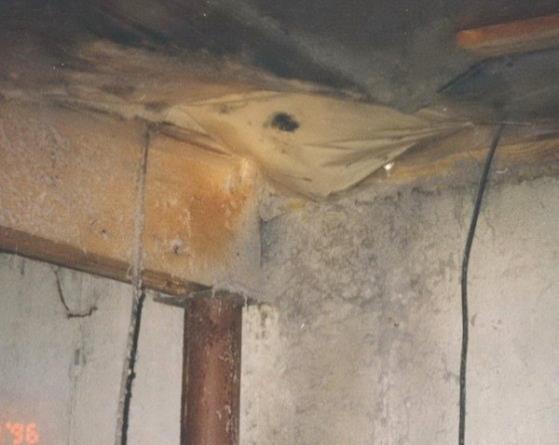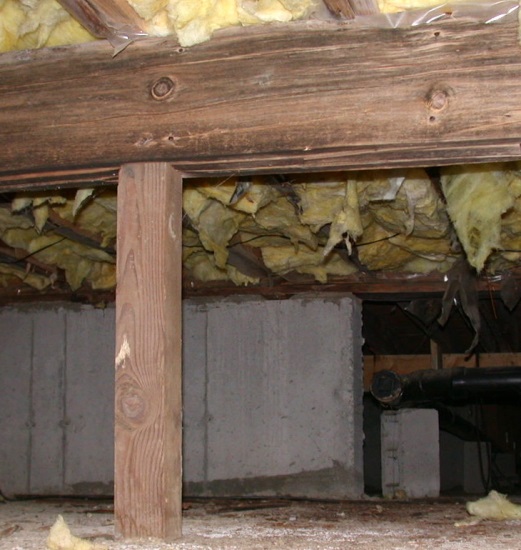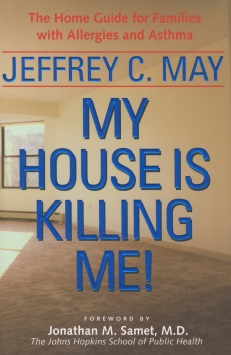IAQ IQ, Spring 2019
©2019 Jeffrey C. May
Air flows don’t fall into the “visible conditions” category, but there are visible conditions that can lead to airborne allergens, contaminants, and irritants.
Combustion Products
A woman who lived out-of-state called our office in the hopes that we could help her. She sometimes experienced headaches and dizziness when she did the laundry. Her husband suspected that she was exaggerating. When I arrived at the property, she was welcoming but he stood back on the staircase with his arms folded and his look icy.
I figured out what the problem might be before I even got out of my car.
The front of the house had a deep L-shape with a three-car garage jutting out on one side and the entranceway on the other. The mechanical room faced the “L” in the front. The room contained the washer and dryer at one end and a direct-vented boiler at the other; the boiler took its combustion air from the room.
The combustion-air intake for the room and the direct-vented exhaust pipe were located about 18 inches from each other at the outside of the L, and there was a deep overhang all along the front of the house. The geometry of this arrangement trapped the combustion products close to the exterior wall at grade, and the products were sucked back into the room through the combustion-air intake. When the woman did laundry when the boiler was operating, she was exposed to elevated levels of carbon monoxide (CO).
The solution? Move the boiler exhaust or the combustion-air intake.
In another case, a real estate agent was running an open house in a small, immaculate single family. It was an antique but had been lovingly renovated. It was a rainy day, so there was very little traffic at the open house. The real estate agent sat quietly in the living room reading a book, when suddenly she felt nauseous and dizzy. She spent the rest of the open house standing outside in the rain, taking in deep breaths.
The boiler exhausted into a chimney that still had an opening for a wood stove that had probably once heated the house but that was no longer present. A loose piece of metal covered the hole. There was only one flue in the chimney. When combustion products entered the chimney, the air took the shortest route back into the living room. The real estate agent might as well have been reading inside the chimney! She had always wondered why the windows in the house were open whenever she was there, and now she knew why.

In a third property—a very tightly constructed, three family—the hot-air furnaces were hung from the ceiling in the multi-car garage. The filter slots were open, so return air was being drawn in from the garage. When automobiles were started up, the garage air contained CO from the cars’ exhaust. My buyers did not purchase the condo but did suggest that Jack Kevorkian might be interested (for those of you too young to remember, Kevorkian was notorious for his CO euthanasia plan).
Ice Damming
In two properties with steam boilers in the basement, there were spaces around the chimney at the basement ceiling. Hot air from the boiler was rising up around the chimney, flowing into the attic, and causing ice damming in the winter, which can lead to paint damage and mold growth.
The Sickening Dryer Hose
Dryers should not be vented for great lengths through cold spaces. I inspected one house in which the dryer vent traveled through an unheated attic. The warm, moist air from the dryer cooled as it traveled through the piping. Water condensed within the piping, leaked out the joints, dripped onto the garage ceiling, and created stains about every six feet where the sections of pipe connected.
In another house, the dryer vented directly into a cold, attached garage. When I looked into the garage I faced a nightmare. Water was dripping from the walls and lint was stuck to surfaces. Moisture and biodegradable material mixed together equal? MOLD!
Bathroom Exhausts
In one house the bathroom exhaust vented into the soffit. Even with the fan off, there was significant passive air flow from the bathroom into the vent grille. I asked the homeowner to feed non-toxic smoke from my smoke pencil into the grille. I stood in the attic to watch the smoke-filled airflow as it flowed into the soffit. The smoke separated into two distinct flows. One narrow laminar band of smoke moved quickly along the sheathing, flowed up to the ridge vent, and then flowed back down the other side of the ridge pole. The second, slower-moving smoke cloud was turbulent and rose slowly until it encountered the ridge pole, at which point it sank to the floor of the attic.
Why was this happening? The sun was shining on the sheathing so the sheathing was warm and created a narrow band of laminar air flow. That air rose up to the ridge and its momentum carried it over the ridge pole; the opening at the ridge vent was inadequate and there was no flow into it. The roiling, turbulent cloud that followed behind was almost the depth of the rafter bay and when it struck the ridge pole, it just sank to the floor.
How many of you have inspected ridge vents installed without an opening in the roof sheathing to accommodate airflow?
Crawl spaces
When crawl spaces are vented to the exterior, outside air can flow into the spaces. If a crawl space is connected to the basement, air can flow from the crawl space into the basement, because the air pressure in the crawl space can be greater than the air pressure in the basement. The vast majority of crawl spaces I’ve inspected contained mold growth because the relative humidity was not being adequately controlled. Crawl spaces open to the exterior can even contain pest infestations if there is exposed fiberglass insulation present (mice love to nest in the stuff). Then mold spores as well as mouse odors can flow into the basement and from there, up into the house.
More than once, I’ve inspected a crawl space into which a dryer was vented. You can just imagine the moisture and moldy lint I saw on all those surfaces.

In two cases, the main beam was decaying!

Central Vacuum Systems
These are great to have, but they should vent to the exterior and not into the basement, garage, or crawl space; otherwise, if the canister is leaky, biodegradable dust can collect on surfaces and lead to mold growth.
Devious Fragrances
I was a home inspector before I became an indoor-air-quality consultant. My nickname among real estate brokers was “Jeff Dismay.” I’ll admit that I am a “glass is half empty” kind of guy, but that helped me be a better home inspector and helps me now in my indoor-air-quality work. I enjoy identifying a problem and specifying the solution.
I also tend to be naturally suspicious about people’s motives. That personality quirk has served me well on many occasions.
Take, for example, when I inspect a property that smells like gardenias, with fragrance emitters plugged into many outlets and/or fragranced jar candles burning on surfaces. What are people hiding, I wonder? They are often hiding noxious odors that could point to a mouse or shrew infestation or to mold growth. If you inspect such a house, insist that fragrance sources be unplugged or removed from the house, because your nose is one of your tools.
On and On
I could go on and on with examples of how airflows in a house can spread contaminants and allergens, and perhaps I’ll raise such issues in future newsletters. For now, I’ll end with some tips arising from the contents of this newsletter.
- When a house has a steam boiler, the gap between the ceiling framing and chimney brick should be stuffed with a non-combustible material; plumbing chases should be similarly sealed. In a house with balloon framing, the wall cavities should also be sealed at the basement level.
- A furnace in a garage should be located within a mechanical closet and should have its own source of combustion air.
- Fresh-air intakes should not be located where they can draw in unwanted contaminants.
- A dryer exhaust hose should have a short run and should vent to the exterior.
- A central vacuum system should vent to the exterior and not into a garage or crawl space.
- A bathroom exhaust should vent to the exterior and not into a soffit or attic.
- Be suspicious if you inspect a house filled with fragrances from jar candles or plug-in fragrance emitters.

This book discusses many of the allergens that can be found in homes; the second edition should be published in 2020.
